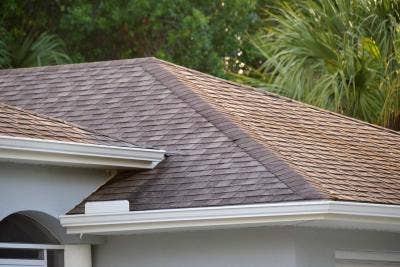6 Checks to Protect Your Roof from Storm Damage

Over the last few years the UK has suffered the effects of a range of inclement weather incidents. Every part of the country from the highlands of Scotland to the coast of Cornwall having, at various times, born the brunt of some spectacularly heavy storms.
And when the storms arrive, so they bring with them the threat of damage to our properties, our belongings, our homes.
Critically, it is the roof of our homes which invariably faces the severest examination in a storm and it's an examination we really need it to pass as unscathed as possible. Our roofs form the front line when it comes to protection against heavy storm conditions. If there's any kind of weakness in its protection it can lead to a myriad of problems that can threaten the well-being of the property as a whole. Anything from material damage that can cause holes, leakages and long-term water damage to lost tiles or even a collapse of the structure.
Of course, there will be times when nature will win; but that doesn't mean we should ignore some critical checks we can make to ensure that our roofs are as robust as they can to stand up the elements when they're needed the most.
Check for leaks along exterior walls
Make a check on the walls on the outside of the house for signs of leakage or potential leaks that could occur during inclement weather. This could be staining on the walls indicating signs of water or check to see if there any cracks apparent, or breakages in the bricks, mortar or anywhere the walls and roof are connected.
Any cracks, missing mortar or other openings which could cause water to leak in should be treated with appropriate sealant to ensure the water tightness of the building.
Checks to the Interior walls, loft and ceilings
Making checks to the inside walls and ceilings when the weather is more friendly can help identify any areas that may be leaky or potential weak spots when the things turn more stormy in the winter time. If there is any sign of damp, water staining or similar it's going to be much easier to identify the location and rectify through adequate sealing while the weather is mild and dry than trying to combat the problem when the rain and wind arrives. Protecting and repairing weak parts of your roof ahead of the storms will offer added peace of mind.
Check the tiles

Similarly it is far easier to check for gaps or breakages to your roof tiles, or even missing tiles altogether, before any storms head your way. This is particularly important if you have not checked the state of your tiles since the last time there was a storm in your vicinity. It might be possible to carry out a visible check on the tiles using binoculars or even the zoom lens on camera. If not, it might pay to have a roofer carry out an inspection.
If you notice a build-up of moss on the roof this can be something to address. Moss can hold moisture and cause damp issues on the tiles which could weaken when inclement weather sets in.
Check the fascia, joints and membrane for signs of deterioration
Cold weather, or big changes in temperature can have a major impact on building materials over time, causing them to expand and contract which in turn can sometimes lead to separations and breaks in sealed areas. This can sometimes occur around joints and fascias, particularly if they have been left unchecked over a period of time. These gaps act as entry points for water and weaken your home's protection.
Make checks around the expansion joints for signs of separation as well as checks to the roof membrane for any evidence of deterioration so that it can be repaired to offer adequate protection during heavy wind and rain.
Check vents, chimney stacks and roof windows for deterioration to joints, seals and flashings
It is common for weak spots to emerge around areas such as the vents, chimney and skylights, particularly again in relation to damage, tears or general deterioration that may have occurred following previous bad weather. Look for gaps in the seals and around the joints as well as potential degradation of the flashing, all of which can create entry points which can have an effect on the roof's durability in adverse weather.
Check guttering and down pipes, clearing as required

Another key area to pay attention to when keeping your roof protected against storm damage is in relation to the guttering and down pipes. Blockages caused by leaves, moss or other foreign elements can cause drainage problems around the roof and walls which are often precursors to weakened roof protection when really bad weather kicks in. Furthermore, you should be checking the condition of joints to ensure that the pipes are free from leaks and robust enough to stand up the poor weather as and when it occurs. Leaky and blocked guttering leads to water not flowing away from the roof and walls as it ought to, which can seriously weaken them if left unrepaired over a period of time. And that can often mean failure in the roof, exactly when you need it the most.
While clearing gutters why not install a gutter brush? They're easy to install and a very low maintenance way of keeping your gutters clear.
Conclusion
When storms and particularly aggressive weather strikes, we want to be sure that our homes and possessions are as protected as possible. That we have a level of security that our roof and our homes in general will stand up to the battering and allow us to remain dry and warm.
Which is why carrying out some simple, regular checks to the structure, integrity and conditions of our roof and related materials is so important. Check when the weather is fine and indeed, following any previous storm you may have been subjected to, so that you can identify repairs in advance to give you peace of mind that, when the next storm comes, your roof will be up to the challenge.
Our Top Videos.


How to install a Velux Integra Electric Roof Window (5 Parts)
In this five-part guide, we take you through the full installation of a Velux GGU Centre Pivot Integra Roof Window onto an...


How to install a Duratech Centre-Pivot Pine Roof Window
Once you begin unpackaging the window, you’ll find in the box the brackets, the handle and the fixings. And there will also be some instructions...
Ideas & Advice
How-tos, tutorials and videos


How and why to use or snap a chalk line
Chalk lines are the fastest way to mark straight guidelines on flat surfaces. They are used extensively in the building and construction industry to speedily and accurately ‘draw’ straight lines between two points. Chalk lines are inexpensive tools...


Skylight Blinds: A Guide To The Different Types
Like many household product, blinds for skylight windows come in all shapes, sizes, and materials. Some are designed with a tangible purpose in mind, while others are more for show. One thing’s for sure - buying any type of skylight blind...








